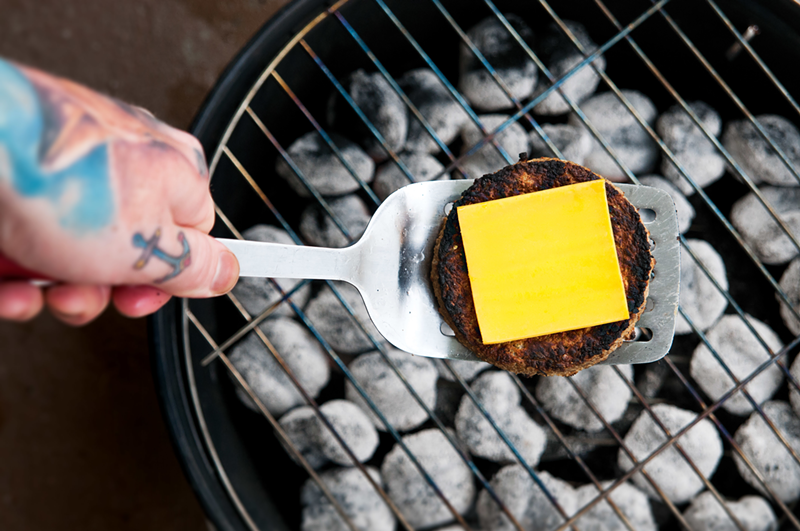A
side from baseball and lounging in pools, grilling just might be America’s favorite summer pastime. From burgers and brats to pizza and pineapple, there’s nothing we won’t try to cook on grates over hot coals or burning gas, relishing in those seared grill marks like a badge of honor. And while we each have our own taste preferences for how to grill our grub, there are some guidelines to follow to make sure your summer cookout is a success.
Leigh Barnhart Ochs, director of The Cooking School at Jungle Jim’s International Market, has cooked and studied with the likes of Julia Child, Anne Willan and Todd English and has taught many grilling classes in her more than 10 years of cooking instruction. Here are some of her favorite tips and techniques for getting your grill on this summer.
CHARCOAL VS. GAS
While some people may be die-hard fans of either charcoal or propane, neither is necessarily superior.
“There are people who prefer the taste of charcoal because it offers more of a flame-grilled, woody flavor,” Barnhart Ochs says. “And then propane is more practical for some people because not everyone has time to start a charcoal fire, and charcoal can be a little messier.”
But Barnhart Ochs offers a third option in the fuel conversation: natural gas. “I grill on natural gas at home because it’s hotter. You hook it up to your gas line and you have to just modify your grill.”
Using natural gas also prevents you from running out of fuel mid-grill or having to constantly refill your propane tank. Barnhart Ochs modified her grill herself with parts from a hardware store, but there are plenty of resources online to help you do it yourself or hire someone if you don’t want to risk blowing up.
TEMPERATURE GUIDELINES
“Most people really want a hot grill to start with,” Barnhart Ochs says. “If you’re doing charcoal, your coals should be mostly ashen gray and shouldn’t be black anymore. If you’re doing gas, I always let mine preheat a minimum of 10 minutes, maybe even longer — 15-20 (minutes) is best.”
Light a charcoal grill about 30-45 minutes before you want to cook to allow the charcoal vapors and lighter fluid to burn off. And grab a chimney starter if you don’t already have one. “A chimney starter for charcoal is very helpful and it’s more environmentally friendly to use newspaper to start your fire instead of lighter fluid,” Barnhart Ochs says.
For the purposes of food safety, always adhere to the U.S. Department of Agriculture’s (usda.gov) internal temperature recommendations. But Barnhart Ochs also says that meat will generally tell you how long to cook it. When it’s done on one side, it should flip easily. “When you put any kind of protein on the grill, don’t try to flip it until it’s ready to release and turn over,” she says. “Don’t push it back and forth or you’re going to lose all the pretty grill marks.”
To see if your grill is ready for cooking, put your hand about three inches away from the grate. Grilling recipes generally use the heat categories of high, medium-high, medium-low and low to gauge temperature. To see if your grill is at a high temperature range (good for searing), you should only be able to hold your hand above the grate for 1-2 seconds. For medium-high heat (good for things like fish), you should be able to hold your hand there for 2-3 seconds. For medium-low heat (for things that stay on the grill longer, like chicken and vegetables), you should be able to hold your hand there for 4-5 seconds. For low-temperature cooking, you should be able to hold your hand there for 6-7 seconds. If you can hold your hand above your grill for more than 10 seconds, it isn’t ready.
TRICKS OF THE TRADE
In her years of cooking and teaching, Barnhart Ochs has come up with some tips to make the grilling process easier.
1. Avoid tin foil
: “If you grill something in tin foil, you’re using your grill like a big oven,” she says. “It can be tempting to do because it makes cleanup easier but you’re really not going to get that flavor.”
2. Double liner
: Some people carry raw meat out to the grill on a cookie sheet and then place the cooked meat back on the same sheet. Barnhart Ochs has a quick tip to make that practice safe and time effective: “Fit the cookie sheet with two sheets of foil. Put the raw meat on the top layer and crunch it up and throw it away once you put the meat on the grill. Then put the cooked meat on the second layer of foil.”
3. Brick trick:
“I always keep foil-lined bricks at my house,” she says. These are great for cooking shrimp. “I put them on the grill spaced depending on how long my skewers holding the shrimp are. Put the pointy tip of the skewer on one brick, and the end of the skewer on other. You can put a whole row of shrimp skewers on there without burning the shrimp.”
4. Creating heat
: For food that doesn’t need to be on the grill for long, Barnhart Ochs says to create uniform, direct heat by firing up all your burners or covering the whole inside of the grill with charcoal. To create indirect heat, which offers a variety of cooking temperatures and a longer cooking time, push your coals to one side of the grill to make a hot side or make a cool spot in the middle by pushing the coals out. If you’re using a gas grill, turn off one or more of the burners.
5. Never use a fork:
Don’t pierce your meat with a grilling fork or you’ll release necessary juices. Use long tongs or a flat spatula to move and remove your proteins.
To wow friends and family at the next cookout, try The Cooking School at Jungle Jim’s Balsamic-Soy Marinated Flank Steak:
Marinade:
2 tablespoons vegetable oil
2 tablespoons balsamic vinegar
2 tablespoons soy sauce
2 scallions, white and green parts, chopped
1 tablespoon Dijon mustard
2 teaspoons chopped fresh rosemary
2 cloves garlic, chopped
1 flank steak, about 1½ pounds
Combine marinade ingredients in a jar with a tight-fitting lid and shake well. Pour marinade over meat in a large resealable plastic bag. Refrigerate 4 hours or overnight.
When ready to grill, remove steak from marinade. Grill over medium-high heat, turning once or twice, until cooked to your preference, about 5 minutes per side for medium-rare. Remove steak from grill and allow to rest 10 minutes before slicing across the grain into thin slices.
Serves 4.






